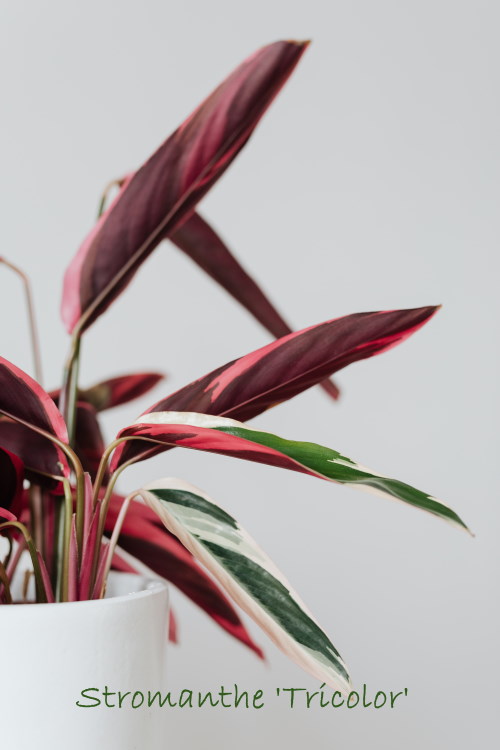Stromanthe Sanguinea
Gorgeous foliage in dramatic colors make Stromanthe sanguinea a must-have for your indoor houseplant collection.
Here you'll discover how to grow this Brazilian native indoors. Find out how to water, divide, and repot this tropical houseplant, plus how to prevent brown leaf tips and other problems.
 Give this tropical foliage plant plenty of light to keep its variegation.
Give this tropical foliage plant plenty of light to keep its variegation.Get to Know Your Houseplant
Each emerald green leaf looks like a masterpiece, brushed with creamy white, light green and sometimes pink. Its leaves are sometimes held upright, revealing red undersides. Those leaves are typically 10-12 inches long and are held on short, upright petioles.
How big will Stromanthe sanguinea get? It will reach a height of up to 3 ft (90 cm) when confined to a container and grown indoors.
If your plant changes its "look" throughout the day, there's a reason. Stromanthe is a member of the Marantaceae family of prayer plants. Its leaves turn to follow the sunlight throughout the day, then close at night, just like its family members.
Caring for Stromanthe Year-Round: Problems, Solutions and Answers
Wondering when to repot Stromanthe? Repot when the plant appears crowded, using a pot that's just 1-2 inches (2.5-5 cm) larger. Keep the crown of the plant at the same level it was in the old pot to prevent stem rot. Spring is a good time, when it is starting its most vigorous time of growth. Use a pot with drainage holes to prevent over-watering. This is a good time to divide plants, if you want.
Brown leaf tips may be caused by dry air. Give this South American rain forest native the moist air it craves year-round. (See "Humidity" below). It's a good idea to use a humidity gauge near your tropical houseplant, rather than guess. Homes can become extremely dry in winter.
Leaves that lose their vivid color may not get enough sunlight. Set your houseplant where it will receive bright, yet indirect light.
Pruning isn't necessary, but older leaves can be cut off when they wither and turn brown. Use sharp pruners or scissors and cut them off close to the soil level.
Is Stromanthe sanguinea poisonous to pets? No, this spectacular plant is safe to have indoors around cats and dogs.
Something bugging your plant? Stromanthe seems to shrug off pests, though there are a couple to watch for. Dry, warm conditions in winter may draw spider mites to indoor plants. You'll first notice their fine webbing between leaves and stems. Treat any infestation immediately to prevent these destructive pests from moving on to your other houseplants. Wet, peaty potting mixes sometimes attract fungus gnats. Allowing the potting medium to dry out a bit between waterings will help prevent them.
 Colorful Stromanthe is a gorgeous houseplant. Photo © Karolina Grabowska
Colorful Stromanthe is a gorgeous houseplant. Photo © Karolina GrabowskaStromanthe Sanguinea Varieties and Buying Tips
This tropical beauty is seldom seen in nurseries and garden centers, but it's well worth seeking.
Stromanthe sanguinea 'Tricolor' is a popular cultivar for its stunning cream, white and green leaves with red undersides. 'Triostar' is splashed with cream, pink and green with red underneath.
Stromanthe Sanguinea Care
Light: Bright light is essential for good leaf color. Put your plant where it'll get plenty of light, but protect Stromanthe sanguinea from hot midday sun, which may cause brown scorch marks on leaves.
Water: Allow top 1-inch (2.5 cm) to dry out before watering. Take care not to over-water -- soggy soil will cause Stromanthe sanguinea stems to collapse, and may lead to root rot. It's a good idea to use a pot with a drainage hole; water thoroughly, then empty drainage tray. Water less in winter, but don't allow the plant to dry out.
Humidity: This tropical rain forest native wants at least 50% relative humidity. Brown leaf tips indicate the humidity is too low. Indoor air can become especially dry in winter; it a good idea to use a cool-mist humidifier near the plant.
Temperature: Average to warm 65-80°F/18-27°C year-round. Stromanthe doesn't like big fluctuations, but will tolerate temps as low as 60°F/16°C in winter. Keep plant away from cold drafts from entryways or blasts from A/C or heat vents.
Soil: Peat moss-based potting mix or other soilless potting medium.
Fertilizer: Feed once a month spring through fall with a balanced water-soluble houseplant fertilizer. Stop feeding in winter, when growth is slower.
Propagation: Divide clumps in spring and pot them separately.


